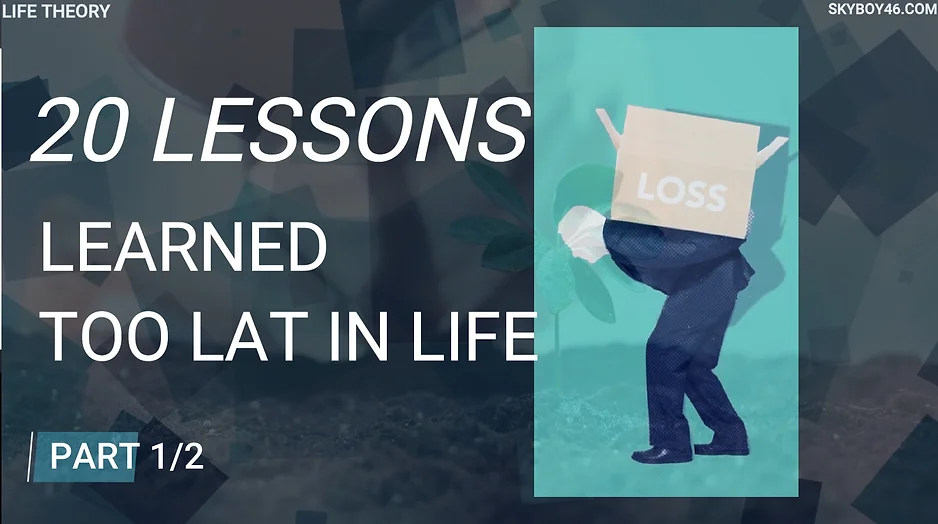Don’t Want To Read?
Watch/Listen To The Full Video on YouTube
Loss changes everything, yet somehow, life keeps moving forward. Grief isn’t a straight road—it’s a spiral staircase, where old pain resurfaces just as you think you’ve left it behind. But here’s the truth: each time grief returns, you’re seeing it from a new vantage point, stronger than before. The climb is exhausting, but with every step, you learn to carry the weight differently, proving that even the deepest sorrow can be transformed into resilience.
SUBSCRIBE: https://www.youtube.com/@LifeTheory46
Climbing Through Grief – A Journey of Resilience – Life Stories 298
Grief is something we all encounter sooner or later—whether it’s the death of a loved one, the end of a cherished relationship, breaking contact with a toxic family member, or the painful collapse of a close friendship. Loss has many faces, and its impact can be profound. Interestingly, evidence suggests that grief isn’t a uniquely human experience; animals like elephants, chimpanzees, horses, and even some birds exhibit behaviors that mirror our own expressions of mourning, suggesting a deeper, more complex process at work.
When it comes to navigating grief, there’s a metaphor that resonates with many: a spiral staircase. It captures the cyclical, often unpredictable nature of healing. Just when it feels like you’ve moved forward—weeks, months, or even years without that familiar ache—something triggers a resurgence of pain, and it can feel just as overwhelming as the day the loss occurred. The setback is disheartening, leaving you questioning why you’re not “over it” yet. But here’s where the staircase image is so powerful: as you ascend, each time you confront that loss, you’re viewing it from a different elevation, a new perspective.
Even if the pain resurfaces, you’re not where you started. If you’ve been actively working on healing, you might notice that the harder days are growing fewer and farther between. The weight doesn’t feel as crushing. Instead of spiraling back down, you pause on a step, catch your breath, and recognize that, this time, the sadness isn’t as deep. Your efforts are paying off, even if it doesn’t always feel that way.
The grief doesn’t disappear entirely—it’s etched into the pillar of your life, stretching upward with you. And as much as we’d like to believe that time itself heals all wounds, the truth is that we must take an active role in that process. Healing requires self-awareness, compassion, and understanding. The work you put into moving through your grief transforms you and lays the foundation for a stronger future.
Grief is universal, yet deeply personal. If you’ve come this far in life without experiencing a profound loss, count yourself among the fortunate few. Most of us will face it, and for those who are grieving right now, it’s okay if you’re not ready to confront these emotions today. But know that exploring these thoughts might help you understand the path you’re walking.
The five stages of grief—denial, anger, bargaining, depression, and acceptance—are familiar terms. They’ve been used to explain the journey of countless individuals who’ve faced traumatic losses. It starts with denial, the instinctive disbelief that a loss is even real. The mind rejects it—“this can’t be happening.” When denial fades, anger often steps in, lashing out at whatever seems to represent the cause of the suffering.
Bargaining follows, pleading with fate, with doctors, or with any higher power that might be listening to undo the loss or at least lessen the pain. But many losses are permanent, and acceptance doesn’t come easily. It’s usually preceded by a period of depression—a profound sense of sorrow and helplessness that varies widely in duration and intensity. This is the hardest stretch of the journey, and for some, it becomes an enduring struggle. Professional help can be essential in these cases, offering the support needed to climb back toward the light.
Acceptance doesn’t mean the pain is gone—it means making peace with its presence. But there’s a lesser-known nuance to this cycle that deserves attention: the idea of grief as a spiral staircase. Picture a tall, winding staircase extending far above the clouds, circling around a central column that represents your life. Each time you experience a loss, a mark is etched into that column, running vertically along its length. No matter how far you climb, you encounter that mark over and over, a reminder of what’s been lost.
But remember, as you continue ascending, you’re not passing that line of grief from the same point of view. You’re higher up, perhaps with a clearer understanding or a different kind of strength. Each time you face that familiar pain, it feels a bit different—not because the loss itself has changed, but because you have.
The journey through grief is not about erasing the pain; it’s about learning to live with it, letting it shape you without letting it consume you. You may revisit the sorrow, but it doesn’t have to pull you backward. As you climb, you’re building resilience. Over time, your grief becomes a part of your strength, not your weakness. The staircase metaphor reminds us that even when the wound feels raw again, we’re not at the bottom—we’re climbing.
Some losses stay with us forever, embedded in our lives. Yet, with every step we take toward understanding and accepting them, we inch closer to a place where they no longer hold us captive. The staircase isn’t just a path through grief; it’s a testament to the growth that emerges from it. And that growth is something to be proud of.
Grief may leave its mark, but it doesn’t define your journey. Each step upward is a step toward healing, even if the climb is steep and exhausting. In time, you’ll find that what once seemed insurmountable can be faced with renewed strength. And that, more than anything, is proof of just how far you’ve come.
–> Read More Life Stories Here:
https://www.lifetheory.us
https://www.lifetheory.eu
Buy all of our Life Stories & Our Premium Learning Packs. Listen or Read to them anytime you want. Have them Forever.
You can get each monthly lesson on our website at https://www.skyboy46.com/store
SHARE THIS STORY
Visit Our Store
SHOP NOW
www.skyboy46.com & www.myskypet.com
Designed For Pet Lovers & Introverted Souls
Sport, Hobbies, Motivation, Music & Art






~EXPLORE MORE~
www.linktr.ee/skyboy46


